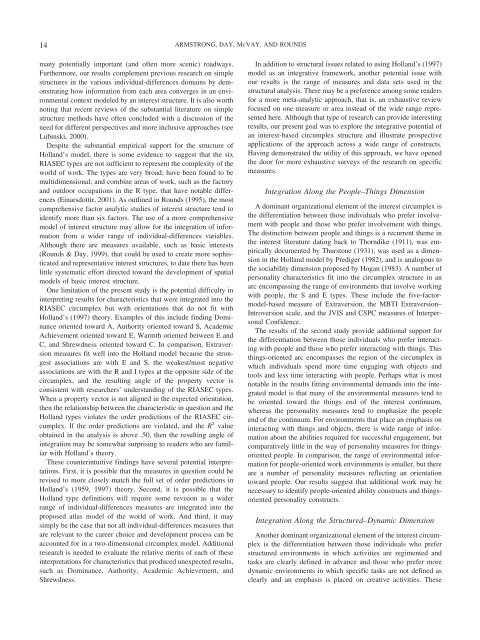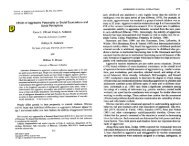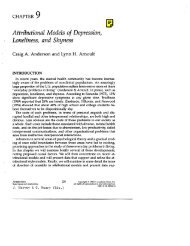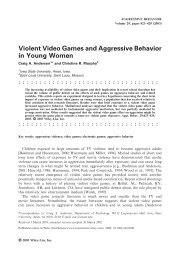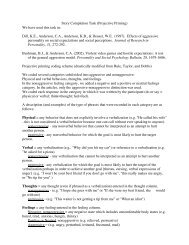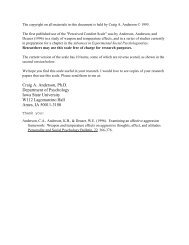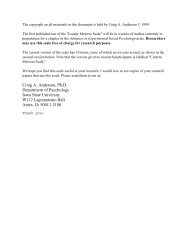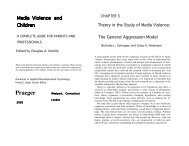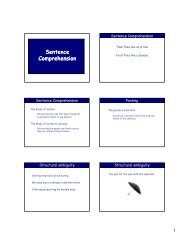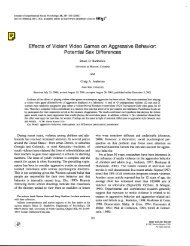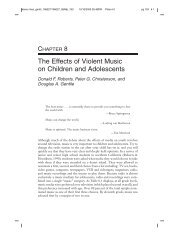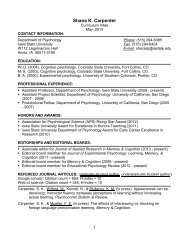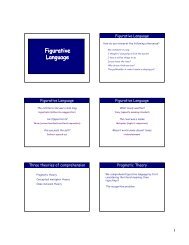Holland's RIASEC Model as an Integrative Framework for Individual ...
Holland's RIASEC Model as an Integrative Framework for Individual ...
Holland's RIASEC Model as an Integrative Framework for Individual ...
You also want an ePaper? Increase the reach of your titles
YUMPU automatically turns print PDFs into web optimized ePapers that Google loves.
14 ARMSTRONG, DAY, MCVAY, AND ROUNDS<br />
m<strong>an</strong>y potentially import<strong>an</strong>t (<strong>an</strong>d often more scenic) roadways.<br />
Furthermore, our results complement previous research on simple<br />
structures in the various individual-differences domains by demonstrating<br />
how in<strong>for</strong>mation from each area converges in <strong>an</strong> environmental<br />
context modeled by <strong>an</strong> interest structure. It is also worth<br />
noting that recent reviews of the subst<strong>an</strong>tial literature on simple<br />
structure methods have often concluded with a discussion of the<br />
need <strong>for</strong> different perspectives <strong>an</strong>d more inclusive approaches (see<br />
Lubinski, 2000).<br />
Despite the subst<strong>an</strong>tial empirical support <strong>for</strong> the structure of<br />
Holl<strong>an</strong>d’s model, there is some evidence to suggest that the six<br />
<strong>RIASEC</strong> types are not sufficient to represent the complexity of the<br />
world of work. The types are very broad; have been found to be<br />
multidimensional; <strong>an</strong>d combine are<strong>as</strong> of work, such <strong>as</strong> the factory<br />
<strong>an</strong>d outdoor occupations in the R type, that have notable differences<br />
(Einarsdottir, 2001). As outlined in Rounds (1995), the most<br />
comprehensive factor <strong>an</strong>alytic studies of interest structure tend to<br />
identify more th<strong>an</strong> six factors. The use of a more comprehensive<br />
model of interest structure may allow <strong>for</strong> the integration of in<strong>for</strong>mation<br />
from a wider r<strong>an</strong>ge of individual-differences variables.<br />
Although there are me<strong>as</strong>ures available, such <strong>as</strong> b<strong>as</strong>ic interests<br />
(Rounds & Day, 1999), that could be used to create more sophisticated<br />
<strong>an</strong>d representative interest structures, to date there h<strong>as</strong> been<br />
little systematic ef<strong>for</strong>t directed toward the development of spatial<br />
models of b<strong>as</strong>ic interest structure.<br />
One limitation of the present study is the potential difficulty in<br />
interpreting results <strong>for</strong> characteristics that were integrated into the<br />
<strong>RIASEC</strong> circumplex but with orientations that do not fit with<br />
Holl<strong>an</strong>d’s (1997) theory. Examples of this include finding Domin<strong>an</strong>ce<br />
oriented toward A, Authority oriented toward S, Academic<br />
Achievement oriented toward E, Warmth oriented between E <strong>an</strong>d<br />
C, <strong>an</strong>d Shrewdness oriented toward C. In comparison, Extraversion<br />
me<strong>as</strong>ures fit well into the Holl<strong>an</strong>d model because the strongest<br />
<strong>as</strong>sociations are with E <strong>an</strong>d S, the weakest/most negative<br />
<strong>as</strong>sociations are with the R <strong>an</strong>d I types at the opposite side of the<br />
circumplex, <strong>an</strong>d the resulting <strong>an</strong>gle of the property vector is<br />
consistent with researchers’ underst<strong>an</strong>ding of the <strong>RIASEC</strong> types.<br />
When a property vector is not aligned in the expected orientation,<br />
then the relationship between the characteristic in question <strong>an</strong>d the<br />
Holl<strong>an</strong>d types violates the order predictions of the <strong>RIASEC</strong> circumplex.<br />
If the order predictions are violated, <strong>an</strong>d the R 2 value<br />
obtained in the <strong>an</strong>alysis is above .50, then the resulting <strong>an</strong>gle of<br />
integration may be somewhat surprising to readers who are familiar<br />
with Holl<strong>an</strong>d’s theory.<br />
These counterintuitive findings have several potential interpretations.<br />
First, it is possible that the me<strong>as</strong>ures in question could be<br />
revised to more closely match the full set of order predictions in<br />
Holl<strong>an</strong>d’s (1959, 1997) theory. Second, it is possible that the<br />
Holl<strong>an</strong>d type definitions will require some revision <strong>as</strong> a wider<br />
r<strong>an</strong>ge of individual-differences me<strong>as</strong>ures are integrated into the<br />
proposed atl<strong>as</strong> model of the world of work. And third, it may<br />
simply be the c<strong>as</strong>e that not all individual-differences me<strong>as</strong>ures that<br />
are relev<strong>an</strong>t to the career choice <strong>an</strong>d development process c<strong>an</strong> be<br />
accounted <strong>for</strong> in a two-dimensional circumplex model. Additional<br />
research is needed to evaluate the relative merits of each of these<br />
interpretations <strong>for</strong> characteristics that produced unexpected results,<br />
such <strong>as</strong> Domin<strong>an</strong>ce, Authority, Academic Achievement, <strong>an</strong>d<br />
Shrewdness.<br />
In addition to structural issues related to using Holl<strong>an</strong>d’s (1997)<br />
model <strong>as</strong> <strong>an</strong> integrative framework, <strong>an</strong>other potential issue with<br />
our results is the r<strong>an</strong>ge of me<strong>as</strong>ures <strong>an</strong>d data sets used in the<br />
structural <strong>an</strong>alysis. There may be a preference among some readers<br />
<strong>for</strong> a more meta-<strong>an</strong>alytic approach, that is, <strong>an</strong> exhaustive review<br />
focused on one me<strong>as</strong>ure or area instead of the wide r<strong>an</strong>ge represented<br />
here. Although that type of research c<strong>an</strong> provide interesting<br />
results, our present goal w<strong>as</strong> to explore the integrative potential of<br />
<strong>an</strong> interest-b<strong>as</strong>ed circumplex structure <strong>an</strong>d illustrate prospective<br />
applications of the approach across a wide r<strong>an</strong>ge of constructs.<br />
Having demonstrated the utility of this approach, we have opened<br />
the door <strong>for</strong> more exhaustive surveys of the research on specific<br />
me<strong>as</strong>ures.<br />
Integration Along the People–Things Dimension<br />
A domin<strong>an</strong>t org<strong>an</strong>izational element of the interest circumplex is<br />
the differentiation between those individuals who prefer involvement<br />
with people <strong>an</strong>d those who prefer involvement with things.<br />
The distinction between people <strong>an</strong>d things is a recurrent theme in<br />
the interest literature dating back to Thorndike (1911), w<strong>as</strong> empirically<br />
documented by Thurstone (1931), w<strong>as</strong> used <strong>as</strong> a dimension<br />
in the Holl<strong>an</strong>d model by Prediger (1982), <strong>an</strong>d is <strong>an</strong>alogous to<br />
the sociability dimension proposed by Hog<strong>an</strong> (1983). A number of<br />
personality characteristics fit into the circumplex structure in <strong>an</strong><br />
arc encomp<strong>as</strong>sing the r<strong>an</strong>ge of environments that involve working<br />
with people, the S <strong>an</strong>d E types. These include the five-factormodel-b<strong>as</strong>ed<br />
me<strong>as</strong>ure of Extraversion, the MBTI Extraversion–<br />
Introversion scale, <strong>an</strong>d the JVIS <strong>an</strong>d CSPC me<strong>as</strong>ures of Interpersonal<br />
Confidence.<br />
The results of the second study provide additional support <strong>for</strong><br />
the differentiation between those individuals who prefer interacting<br />
with people <strong>an</strong>d those who prefer interacting with things. This<br />
things-oriented arc encomp<strong>as</strong>ses the region of the circumplex in<br />
which individuals spend more time engaging with objects <strong>an</strong>d<br />
tools <strong>an</strong>d less time interacting with people. Perhaps what is most<br />
notable in the results fitting environmental dem<strong>an</strong>ds into the integrated<br />
model is that m<strong>an</strong>y of the environmental me<strong>as</strong>ures tend to<br />
be oriented toward the things end of the interest continuum,<br />
where<strong>as</strong> the personality me<strong>as</strong>ures tend to emph<strong>as</strong>ize the people<br />
end of the continuum. For environments that place <strong>an</strong> emph<strong>as</strong>is on<br />
interacting with things <strong>an</strong>d objects, there is wide r<strong>an</strong>ge of in<strong>for</strong>mation<br />
about the abilities required <strong>for</strong> successful engagement, but<br />
comparatively little in the way of personality me<strong>as</strong>ures <strong>for</strong> thingsoriented<br />
people. In comparison, the r<strong>an</strong>ge of environmental in<strong>for</strong>mation<br />
<strong>for</strong> people-oriented work environments is smaller, but there<br />
are a number of personality me<strong>as</strong>ures reflecting <strong>an</strong> orientation<br />
toward people. Our results suggest that additional work may be<br />
necessary to identify people-oriented ability constructs <strong>an</strong>d thingsoriented<br />
personality constructs.<br />
Integration Along the Structured–Dynamic Dimension<br />
Another domin<strong>an</strong>t org<strong>an</strong>izational element of the interest circumplex<br />
is the differentiation between those individuals who prefer<br />
structured environments in which activities are regimented <strong>an</strong>d<br />
t<strong>as</strong>ks are clearly defined in adv<strong>an</strong>ce <strong>an</strong>d those who prefer more<br />
dynamic environments in which specific t<strong>as</strong>ks are not defined <strong>as</strong><br />
clearly <strong>an</strong>d <strong>an</strong> emph<strong>as</strong>is is placed on creative activities. These


